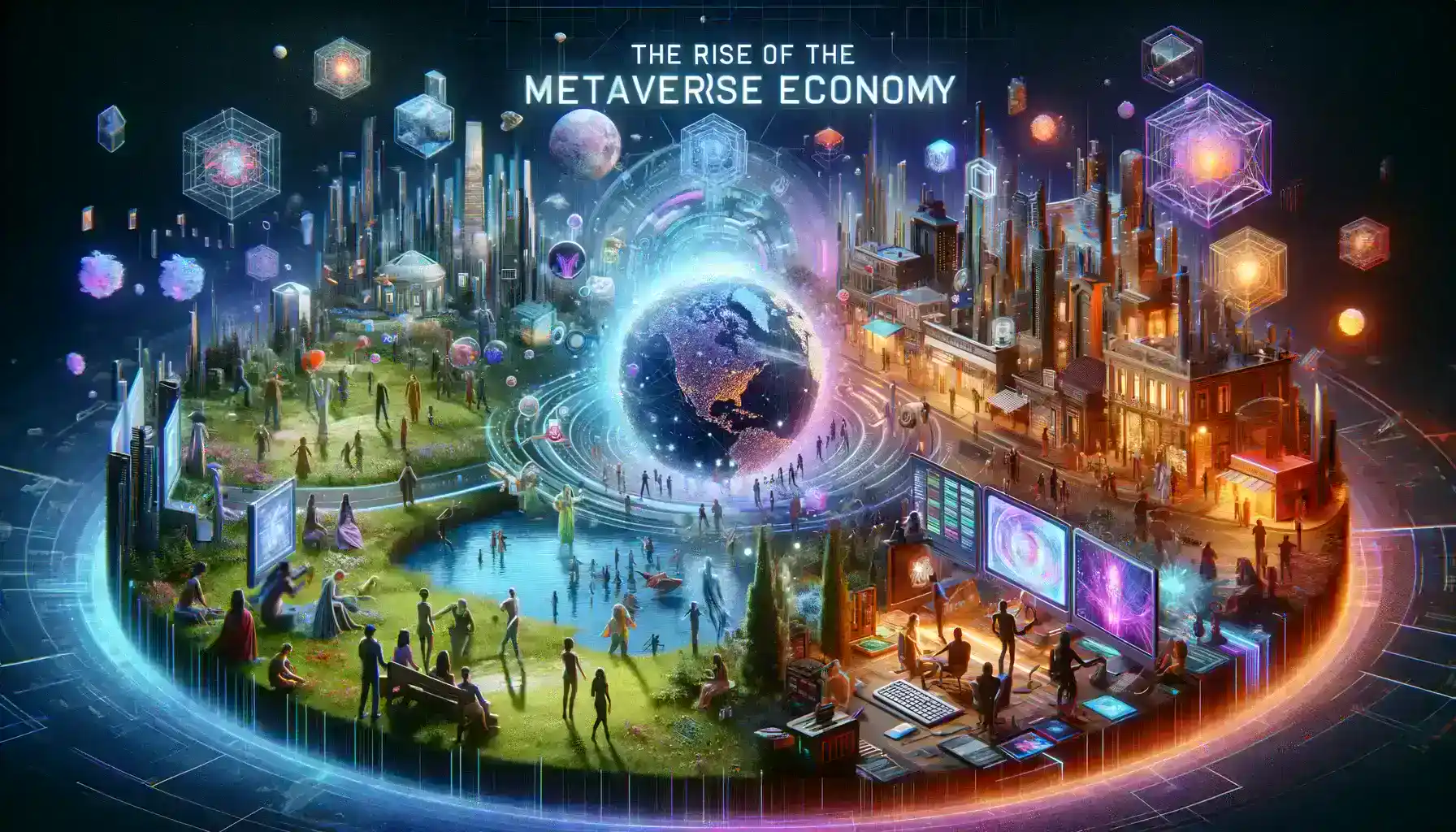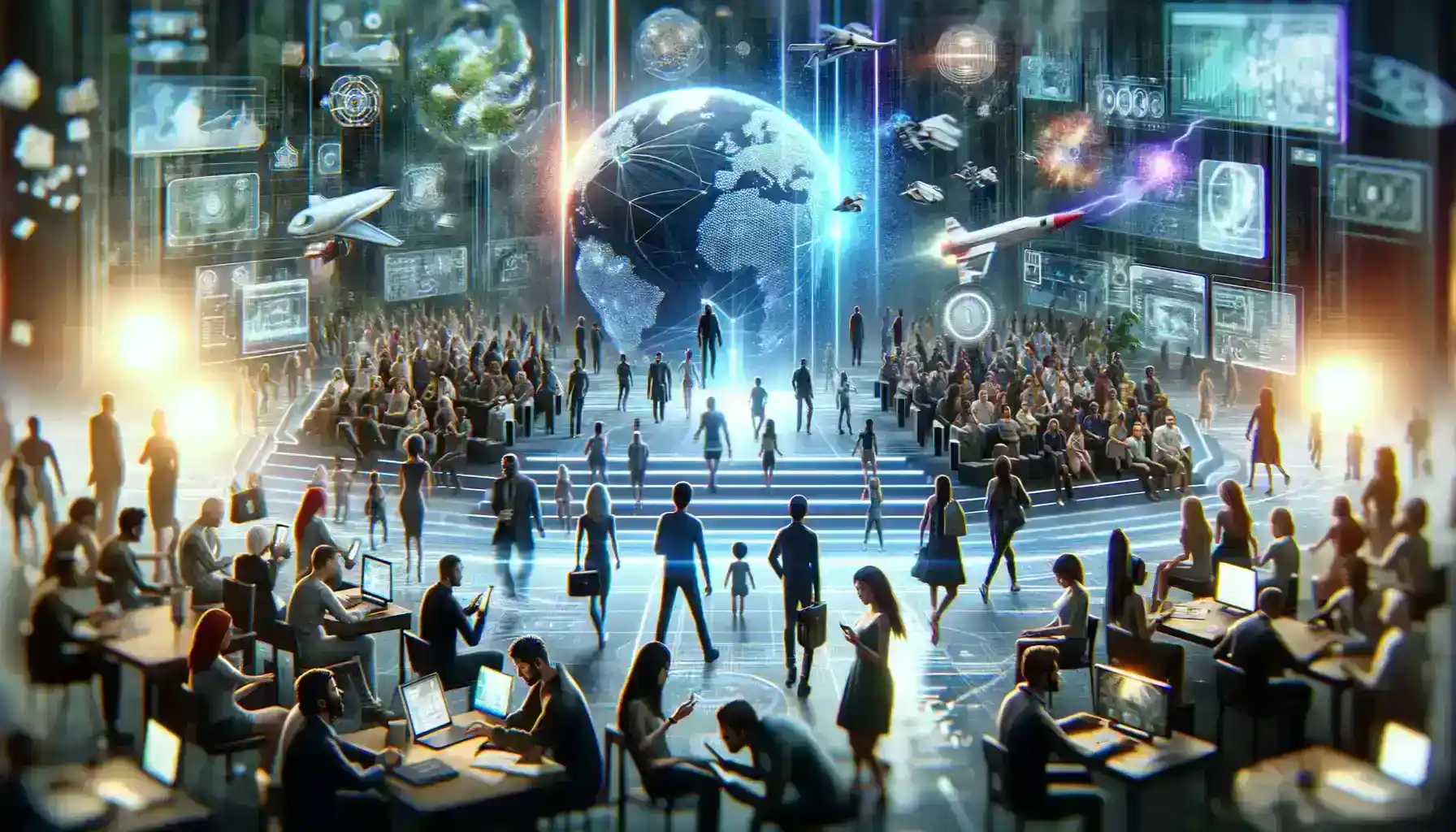Table of Contents
In recent years, the Metaverse has emerged as more than just a buzzword; it represents a burgeoning digital universe, reshaping our perception of virtual interaction and online communities. At its core, the Metaverse is an expansive network of 3D virtual worlds, seamlessly integrated to provide an immersive experience that blurs the lines between physical and digital realities. This convergence of virtual reality (VR), augmented reality (AR), and the internet creates a sprawling digital landscape where users can live, work, and play in ways previously confined to science fiction.
The economic potential of the Metaverse is as vast as its virtual territories. It’s not just a playground for tech enthusiasts but a burgeoning market with real financial stakes. In this digital gold rush, virtual real estate, in-world assets, and digital services are being traded for substantial sums, mirroring the dynamics of the real-world economy. The Metaverse economy, growing at an unprecedented pace, is propelled by significant investments from tech giants, startups, and users alike, all looking to stake their claim in this virtual frontier.
The Rise of the Metaverse Economy

The Metaverse economy is a burgeoning digital realm where individuals and businesses engage in various economic activities within virtual environments. It encompasses a wide range of virtual assets and services, including virtual real estate, digital goods, and immersive experiences. Essentially, it’s an extension of the physical world into the digital realm, where users buy, sell, and trade digital assets, mirroring real-world economic dynamics.
Virtual Real Estate: Within the Metaverse, virtual real estate refers to digital parcels of land that users can purchase and develop. These properties can range from bustling virtual cities to serene countryside landscapes. The ownership of virtual real estate opens up opportunities for businesses and creators to build virtual experiences and generate income through virtual property transactions.
Digital Goods and Services: The Metaverse economy includes a vast marketplace for digital goods, such as virtual fashion items, skins for avatars, and digital art. Users can buy and sell these digital assets, creating a thriving market for virtual collectibles and lifestyle choices. Additionally, services offered within virtual environments, like virtual concerts or virtual tourism, contribute significantly to the Metaverse economy.
Growth Factors:
Several factors are driving the rapid growth of the Metaverse economy:
Technological Advancements: Improved virtual reality (VR) and augmented reality (AR) technologies have made the Metaverse more accessible and immersive, attracting a broader user base.
Increased User Engagement: The pandemic accelerated the adoption of virtual socialization and entertainment, creating a surge in user engagement within the Metaverse.
Investment by Tech Giants: Companies like Meta (formerly Facebook) and Microsoft have made substantial investments in Metaverse development, signaling its potential as a major digital frontier.
Decentraland and The Sandbox serve as compelling real-world instances of the Metaverse economy’s growth. In Decentraland, users can purchase virtual land parcels using the cryptocurrency MANA. Some of these parcels have sold for millions of dollars, with users developing and monetizing their properties. Similarly, The Sandbox offers a platform for creating, owning, and monetizing gaming experiences within a virtual world, with virtual land sales and in-game assets reaching substantial valuations. These models illustrate the tangible economic value and investment opportunities emerging within the Metaverse.
Monetization Strategies in the Metaverse
Monetization in the Metaverse is a multifaceted landscape that offers businesses a wide array of strategies to capitalize on this virtual frontier. Here’s an elaboration on the two key monetization strategies mentioned, along with real-world samples:
Virtual Goods and Services: In the Metaverse, businesses can generate substantial revenue by selling a myriad of virtual goods and services. These encompass everything from digital fashion items like clothing and accessories for avatars to virtual experiences, such as games, concerts, and immersive events. Users are willing to spend real money on these digital assets to enhance their virtual presence or enjoyment.
For instance, fashion brands like Gucci have ventured into the Metaverse by selling exclusive virtual items on platforms like Roblox. Users can purchase Gucci-branded virtual fashion pieces for their avatars, bridging the real and virtual worlds. This strategy not only boosts the brand’s visibility but also generates revenue from the sales of these virtual fashion items.
Advertising and Sponsorships: Virtual environments within the Metaverse have introduced innovative advertising and sponsorship opportunities. Brands can engage with users in novel ways, such as hosting virtual events, product placements in games, or sponsoring virtual spaces.
A prime illustration is the integration of virtual concerts in games like Fortnite. Musicians and brands collaborate to host virtual concerts within the game, attracting millions of players who attend these events. These virtual concerts serve as promotional platforms for both the musician and the brand sponsoring the event. It’s an ingenious way to reach a massive and engaged audience while monetizing the experience through in-game purchases and virtual merchandise.
Cryptocurrency in the Metaverse
Digital currencies like Ethereum and virtual tokens have become the backbone of the metaverse economy.
Axie Infinity: This blockchain-based game allows players to collect, breed, and battle fantasy creatures called Axies. Players earn cryptocurrency by participating in battles and completing quests.
Decentralized Finance (DeFi) in Metaverse: Platforms like Aave and Compound have extended their DeFi services to the metaverse, allowing users to earn interest and borrow assets within virtual worlds.
Virtual Commerce and Advertising

Traditional businesses are recognizing the potential of the metaverse for marketing and commerce. Examples include:
Nike’s Virtual Sneaker Drop: Nike conducted a virtual sneaker drop event in Decentraland, where users could purchase limited-edition virtual sneakers.
Virtual Showrooms: Car manufacturers like BMW and Audi have set up virtual showrooms, allowing users to explore and customize their dream cars within the metaverse.
Challenges and Considerations
Technical Challenges
Scalability: As the Metaverse grows, maintaining a seamless and immersive experience for users becomes increasingly challenging. Scaling the infrastructure to accommodate millions of concurrent users and vast virtual environments is a monumental task. Decentralized solutions like blockchain face scalability issues, with slow transaction times and high fees.
Interoperability: Different virtual worlds and platforms often operate in silos, limiting the flow of digital assets and data between them. Achieving interoperability, where assets can seamlessly move across various Metaverse ecosystems, requires standardized protocols and agreements.
User Experience: The Metaverse’s success hinges on user experience. Achieving realism, low latency, and intuitive interfaces is an ongoing challenge. Ensuring that users can easily navigate between virtual spaces, interact with others, and access content is crucial for adoption.
Economic Risks
Volatility of Virtual Assets: Virtual assets, such as cryptocurrency and NFTs (Non-Fungible Tokens), are known for their price volatility. Users and investors can experience substantial gains or losses in a short period. The Metaverse economy’s reliance on these assets poses financial risks for participants.
Regulatory Challenges: Governments worldwide are grappling with how to regulate virtual assets and Metaverse activities. Taxation, securities laws, and consumer protection are just a few areas where regulations are evolving. Uncertainty in this regulatory landscape can impact investments and business operations.
Ethical and Social Considerations
Privacy and Data Security: The Metaverse collects vast amounts of user data, from behavioral patterns to personal information. Safeguarding this data from breaches and misuse is a significant concern. Users must trust that their privacy is respected.
Social Impact: The Metaverse’s immersive nature blurs the line between virtual and real life. This can have positive effects, such as providing new opportunities for people with disabilities. However, it also raises concerns about addiction, social isolation, and the impact on mental health.
Digital Divide: Access to the Metaverse is not equitable. Socioeconomic disparities can limit access to advanced technology required to participate fully. Bridging the digital divide is essential to ensure inclusivity.
Future of the Metaverse Economy
The future of the Metaverse economy is a topic of great anticipation and intrigue. As we look ahead, several key predictions and trends are emerging, offering a glimpse into what lies on the horizon.
Predictions and Trends
Hypergrowth: The Metaverse economy is poised for explosive growth, with experts foreseeing an influx of new users, businesses, and investments. The virtual world will continue to expand, potentially becoming a parallel digital universe that rivals the physical one.
Metaverse as a Business Ecosystem: It’s expected that the Metaverse will evolve into a comprehensive business ecosystem, encompassing everything from entertainment and education to commerce and social interactions. Entrepreneurs and established companies will vie for a stake in this lucrative space.
NFT Integration: Non-fungible tokens (NFTs) will play an even more significant role, not only as collectibles but also as digital identifiers and proof of ownership for virtual assets. This will open up new avenues for creators and businesses to monetize digital content.
Closing Remarks
In navigating the Metaverse economy, there are both exciting opportunities and formidable challenges. The opportunities lie in the potential for immense wealth creation, novel business models, and immersive experiences. Individuals and businesses can thrive by embracing innovation and adapting to this digital frontier.
However, challenges such as technical hurdles, regulatory uncertainties, and ethical considerations must be addressed. Ensuring a safe and inclusive Metaverse experience for all users is paramount. Additionally, maintaining a balance between profit-seeking and responsible stewardship of virtual spaces will be crucial for long-term success.

Conclusion: Navigating the Virtual Gold Rush
In the fast-evolving Metaverse economy of 2024, seizing opportunities and accumulating wealth is within reach. However, a successful journey in this digital frontier demands more than mere enthusiasm. To harness the Metaverse’s full potential, one must stay informed and adaptive.
Investors venturing into virtual real estate or digital asset trading should be aware of the remarkable profits but also the volatility inherent to this landscape. Businesses engaging in the Metaverse, like Facebook (Meta), and Microsoft, and innovative startups, must embrace innovation and user communities.
The Metaverse’s promising future relies on overcoming technical, economic, and ethical challenges. Scalability, interoperability, and user experience must be prioritized. Regulatory uncertainties and data privacy concerns require diligent attention. Navigating it successfully requires a blend of innovation, adaptability, and a keen awareness of the ever-shifting digital terrain. Brace yourselves for the Metaverse Economy, but tread wisely.